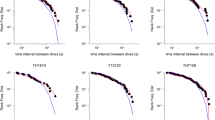Summary
-
1.
We described locomotor activity patterns in fiddler crabs by the frequency distributions of the duration of single activity bouts and of single rests. No significant interrelations between consecutive activity bouts and rests were detectable. The analysis of the frequency distributions led to the conclusion that the patterning of activity behaviour in constant conditions can be described by stochastic processes (Lehmann, Neumann, Kaiser, 1974).
-
2.
Using the very parameters of the analysis we simulated activity patterns with two models. In model 1 the duration of each activity bout or rest is determined at its onset by one stochastic decision using the observed frequency distributions (Fig. 1). In model 2 the transition from one state (activity or resting) to the alternative state is controlled by a series of consecutive stochastic decisions at regular intervals (Fig. 2).
-
3.
The simulated activity patterns produced by the two models using the data of freerunning crabs are similar to the original patterns. They are rather random and give only for short sequences the impression of a weak rhythmicity (Figs. 5, 9, 11).
-
4.
Simulation with the data of the only one crab which displayed a spontaneous circadian rhythm yielded rhythmic patterns despite the fact that no serial correlations and no phase control were fed into the simulation (Fig. 14).
-
5.
Simulation with the data of crabs which were entrained by artificial tides also yielded distinctly rhythmic patterns (Figs. 17, 18).
-
6.
The results of 4. and 5. demonstrate that the preference of a certain duration of the rests is sufficient to organize an activity pattern rhythmically without additional control by an endogenous oscillator.
-
7.
Entrainment of the activity by a Zeitgeber regime was simulated with an extended model 2: The supposed external cycle influences the transition probabilities from activity to resting and vice versa. According to the strength of the external influence the simulation produces more or less strictly synchronized patterns (Fig. 21).
-
8.
The variation in the results of the stochastic simulations demonstrates the effects of chance. Simulations may be used to scan the range of random variations.
-
9.
The involvement and the properties of an endogenous oscillator can not be deduced with certainty from an observed rhythmic pattern only, since the properties of behavioural mechanisms may be sufficient to produce a fairly clear periodicity.
Similar content being viewed by others
References
Barnwell, F. H.: Daily and tidal patterns of activity in individual fiddler crabs (genusUca) from the Woods Hole region. Biol. Bull.130, 1–17 (1966)
Blume, J., Bünning, E., Müller, D.: Periodenanalyse von Aktivitätsrhythmen beiCarcinus maenas. Biol. Zbl.81, 569–573 (1962)
Dahl, O.-J., Nygaard, K.: Simula. A language for programming and description of discrete event systems, 5. ed. Oslo: Norwegian Computing Centre 1967
Enright, J. T.: The search for rhythmicity in biological time-series. J. theoret. Biol.8, 426–468 (1965)
Ferschl, F.: Markovketten. Berlin-Heidelberg-New York: Springer 1970
Gourley, E. V.: Circadian activity rhythm of the gopher tortoise (Gopherus polyphemus). Anim. Behav.20, 13–20 (1972)
Honegger, H.-W.: Rhythmic motor activity responses of the California fiddler crabUca crenulata to artificial light conditions. Mar. Biol.18, 19–31 (1973a)
Honegger, H.-W.: Rhythmic activity responses of the fiddler crabUca crenulata to artificial tides and artificial light. Mar. Biol.21, 196–202 (1973b)
Honegger, H.-W.: Sensitivity ofUca endogenous rhythms to two Zeitgebers, light-dark and tides. In: Biological rhythms in the marine environment (DeCoursey, P. J., ed.). Columbia, S. C.: University of South Carolina Press (in press)
Karlin, S.: A first course in stochastic processes. New York-London: Academic Press 1969
Kavanau, J. L.: Continuous automatic monitoring of the activities of small captive animals. Ecology44, 95–110 (1963)
Kleitman, N., Engelmann, T. G.: Sleep characteristics of infants. J. appl. Physiol.6, 269–282 (1953)
Knuth, D. E.: The art of computer programming, vol. 2, Seminumerical algorithms. 2. ed. Reading, Mass.: Addison-Wesley 1971
Lehmann, U., Neumann, D., Kaiser, H.: Gezeitenrhythmische und spontane Aktivitätsmuster von Winkerkrabben. I. Ein neuer Ansatz zur quantitativen Analyse von Lokomotionsrhythmen. J. comp. Physiol.91, 187–221 (1974)
Lehmann, U.: Interpretation of entrained and free-running motor activity patterns inUca. In: Biological rhythms in the marine environment (DeCoursey, P. J., Ed.). Columbia, S. C.: University of South Carolina Press (in press)
Markl, H., Fuchs, S.: Klopfsignale mit Alarmfunktion bei Roßameisen (Camponotus, Formicidae, Hymenoptera). Z. vergl. Physiol.76, 204–225 (1972)
Markl, H., Hauff, J.: Die Schwellenkurve des durch Vibration ausgelösten Fluchttauchens von Mückenlarven. Naturwissenschaften60, 432–433 (1973)
Nakahama, H., Ishii, N., Yamamoto, M., Saito, H.: Stochastic properties of spontaneous impulse activity in central single neurons. Tohoku J. exp. Med.104, 373–409 (1971)
Narayan Bhat, U.: Elements of applied stochastic processes. New York: Wiley 1972
Naylor, E.: Tidal and diurnal rhythms of locomotory activity inCarcinus maenas (L.). J. exp. Biol.35, 602–610 (1958)
Palmer, J. D.: Tidal rhythms: the clock control of the rhythmic physiology of marine organisms. Biol. Rev.48, 377–418 (1973)
Perkel, D. H., Gerstein, G. L., Moore, G. P.: Neuronal spike trams and stochastic point processes. I. The single spike train. Biophys. J.7, 391–418 (1967)
Rodieck, R. W., Kiang, N. Y.-S., Gerstein, G. L.: Some quantitative methods for the study of spontaneous activity of single neurons. Biophys. J.2, 351–368 (1962)
Thimm, F.: Sequentielle und zeitliche Beziehungen im Reviergesang des Gartenrotschwanzes (Phoenicurus phaenicurus L.). J. comp. Physiol.84, 311–334 (1973)
Webb, H. M.: Effects of artificial 24-hour cycles on the tidal rhythm of activity in the fiddler crab,Uca pugnax. J. interdiscipl. Cycle Res.2, 191–198 (1971)
Webb, H. M., Brown, F. A. Jr.: Interactions of diurnal and tidal rhythms in the fiddler crab,Uca pugnax. Biol. Bull.129, 582–591 (1965)
Williams, B. G., Naylor, E.: Spontaneously induced rhythm of tidal periodicity in laboratoryrearedCarcinus. J. exp. Biol.47, 229–234 (1967)
Wolffgramm, J.: Lautmustersequenzen und periodische Beziehungen im Rollerkanari-Gesang (Serinus canaria L.). J. comp. Physiol.85, 65–88 (1973)
Author information
Authors and Affiliations
Additional information
Supported by the Deutsche Forschungsgemeinschaft.
Rights and permissions
About this article
Cite this article
Kaiser, H., Lehmann, U. Tidal and spontaneous activity patterns in fiddler crabs. J. Comp. Physiol. 96, 1–26 (1975). https://doi.org/10.1007/BF00611959
Received:
Issue Date:
DOI: https://doi.org/10.1007/BF00611959




